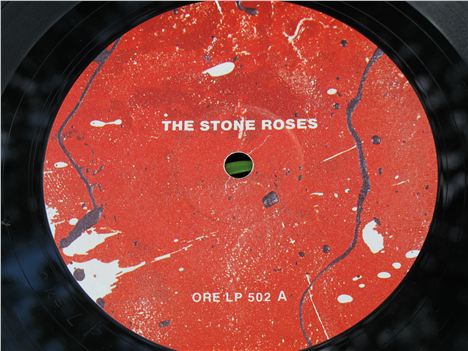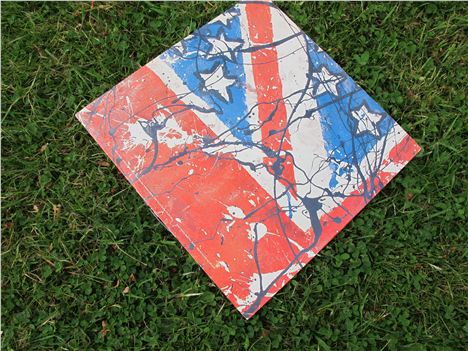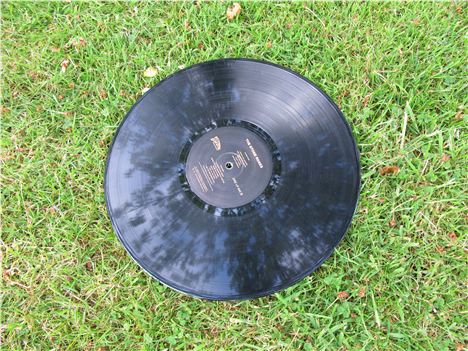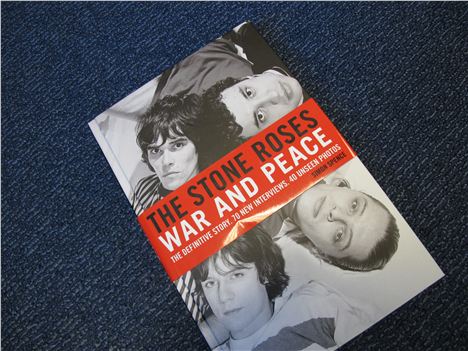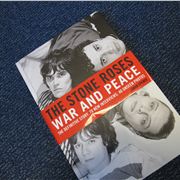 The definitive guideSimon Spence has written 'the definitive story' of The Stone Roses. You can win copies here.
The definitive guideSimon Spence has written 'the definitive story' of The Stone Roses. You can win copies here.
The book has already been acclaimed a classic piece of music literature by everyone from impartial critics on 6music to fans with a deep and enduring love for the group.
In the first of four extracts, that for space reasons couldn't be included in the final book, Spence discusses the origin of the Madchester 'look'.
Extract One: FLARES
I adopted the classic Roses ‘look’ after witnessing their Blackpool Empress Ballroom show in 1989 – and it was that look, more than anything, that had allowed me to kick-start my career at the NME, i-D and The Face (yes, the media back then was that fickle). So I was enthusiastic to find out the origins of the look for War and Peace, particularly the band’s famous flared trousers which became such a media talking point and key signifier for the Roses during their golden period.
It was some of my favourite material in the book. I really loved the attention to detail. But, to keep the narrative pace, I had to trim it to within an inch of its life. Here, thanks to Manchester Confidential, is some of the richer detail we had to leave out.
The Madchester 'look develops
It is late 1983. The Roses have just formed and their image is still, at best, ill defined. Each member looks like they belong to a different band from a different era. Vest tops, roll necks, paisley shirts, leather waistcoats, cardigans, suede jackets, berets, ruffle shirts, bandanas… and tight-legged trousers.
Meanwhile, on a market stall in the centre of Manchester, former Twisted Wheel DJ, Phil Saxe, is back in town. He had been away in Hull, working as a marketing manager for the toy division of model kit and paint manufacturer Humbrol, but is now in business with his brother - starting a fashion revolution.
“We were selling jeans and clothes on a market stall in the Arndale, not the underground market as is sometimes claimed,” Saxe said. “It was my brother’s business and it was called Gangway. We used to sell stuff to the scally sort of element. One day three girls came in; they were probably 15 or 16 year olds and they used to have what we called palm tree haircuts - hair bunched up on the top of their head with an elastic band round it. They asked do you ever get any flares in? I said why? Why flares? They said, we're on the dole, we can’t afford stretch jeans, so we thought if anybody had any flares we’d wear flares. So I go to this warehouse; there were some guys in town we used to call the Iranians who used to buy these huge packages of dead stock from firms like Levi’s, like £100,000 of stuff, without knowing what it was. Market traders and people with shops would go in to their warehouse and sort out what they wanted. So I went in and found some flared cords. I bought about four pairs. The girls came in the next day, tried them on and all bought a pair each. I thought wow that’s a bit different.
“Then people started to coming to the stall, a couple more girls, the odd boy, asking have you got any more flares?” recalled Saxe. “What you have to remember is when a style goes out of fashion the first people to stop wearing it are 26, 28 and 30-inch waist, the youngsters. So all the stock that’s left is exactly the right size for when it comes back into fashion again with the youngsters; all old stock tends to be small sizes. I remember my brother going to a warehouse in Middleton and buying 1,000 pairs of 28-inch waist flared jeans, Levi’s – 18, 20 and 25-inch bottom flares, at £1 each. Within two months we were selling thousands of them. We were the only people in Britain selling them. This was late 1983, though 1984.
"Macca, who ended up managing [Madchester era band] Northside, started working for us. We then went to a double market stall, then the whole ground floor of Kendals. I would drive around the country and go to Army & Navy stores and buy up their old stock; they couldn’t give it away. Then we found out that Wrangler had loads and loads of old stock of 18-inch cords, and they were called semi-flares – even though they were just parallels, just 18-inch cords really – and that became the width. In fact very quickly the extremes, the 25-inch bottoms became very passé. I think part of that was that Manchester City fans tended to wear the very wide 25-inch. At that time you could always tell Manchester City and Manchester Utd fans anywhere in the country. City fans wore 25-inch and Utd fans wore 18 or 20-inch semi-flares; thought they were a little bit smarter.
“In those very early days there was only me and our kid doing it,” added Saxe. “The only other place at that time that did something a little bit similar was a guy called Chinese Jimmy. He used to be based on Oldham Street. Then all these firms starting thinking, wait a minute something’s going on and that buggered it up because, instead of buying something for £1, £2 or £4, we had to pay the full price. So we were paying £10 and had to sell the buggers for £20 and £25 - and everybody could get hold of them. That sort of ruined the differentiation of our business. Then I left and started managing the Mondays.”
“The Mondays were probably customers in that first week at the stall, that’s how I met them,” said Saxe. “They were the first group of boys to come in looking for flares. They also had paisley shirts on, flowery shirts, looked different to everyone else; little beards, all that sort of stuff. Shaun and Paul and Knobhead out of the band and a few of their mates were the first ones.”
With Saxe as manager, the Mondays started on their upward ascent, signing to Factory Records (where Saxe would eventually take the role of Head of A&R).
The Roses, at the time, had an antagonistic approach toward the Factory scene that dominated Manchester. An early song, Fall, was an attack on label boss Tony Wilson. The situation was further aggravated when former Hacienda manager and Factory director, Howard Jones, and Joy Division/New Order producer (among many others) Martin Hannett, the key musical force behind Factory, left the label to respectively manage and produce the Roses. In fact Wilson deliberately scheduled the release of the first Mondays record, in August 1985; an EP called Forty Five, to coincide with the release of the first Roses record, So Young (released on Hannett and Jones’ new label Thin Line, or ‘Renegade Records’ as Wilson dubbed it). Wilson would spend the next few five years attempting to promote a war of the bands - between the Roses and the Mondays - that only existed in his head.
Stephen ‘Cressa’ Cresser
There were many shared links between the two bands. Ian Brown called the Mondays the ‘best band in Manchester’, and the Roses took many musical cues from the band Factory were promoting as the ‘Happy Hooligans’. Stephen ‘Cressa’ Cresser was the main bridge between the two groups. Saxe thought he was Reni’s brother. Cressa had known Squire and Brown from the early 1980s Scooterboy scene – he didn't have a scooter but would often hop on the back of someone else’s. He hung out with both the Mondays and Roses at rehearsals (for a while both bands rehearsed at the same place, the legendary Spirit studios). As the Roses were only playing sporadic gigs in this period, Cressa became a roadie for the more active Mondays.
It was Cressa who had introduced the Roses to the Love album Forever Changes and he was a rich source of knowledge on 60s psychedelic punk rock. In fact his influence on John Squire’s musical tastes was substantial. Cressa listed The Electric Prunes, Chocolate Watch Band, Nazz, Creation, the Nuggets albums, plus contemporary American Paisley Underground bands such as Rain Parade, Green On Red, The Three O'Clock, Plan 9, and Husker Du as key listening. Of the then current British music scene he and Squire shared a passion for The Jesus And Mary Chain.
Howard Jones, the Roses manager, recalled Cressa spending a lot of time at his flat digging through his record collection. “He’d be listening to Steve Miller and The Byrds and a lot of that stuff started to influence Johnny [Squire]. They wore out my copy of Forever Changes.” There were other tunes and albums that got repeated plays at Jones’s flat such as Songs For Our Ancestors from the Steve Miller album Sailor and the 1972 Todd Rundgren album Something/Anything. Jones himself was obsessed with the Geffen record label home to his favourite artiste David Blue, “the guy Dylan wrote It’s All Over Now, Baby Blue about”. The Roses would go on to sign to Geffen in 1991. “I thought David Geffen was a genius,” said Jones. Squire, he said, had paid particular attention to this fascination.
The Hacienda was Cressa’s home from home where he formed part of small clique that included DJ ‘Little Martin’ Pendergast and Al Smith. Smith would become a key part of the Roses crew and Little Martin was another cultural influence. They were regular faces at No Funk, a popular Tuesday night at The Hacienda with DJ John Tracy playing ‘alternative’ current music mixed with 60s sounds such as Break On Through by The Doors, The Chocolate Watch Band and The Seeds.
Little Martin was also a DJ at the Hacienda. He shared a Friday night called Nude with DJ Mike Pickering, who recalled Nude as being ‘Manchester’s first scally night’. Little Martin was a regular at dance import specialist shop, Spin Inn, and popular Nude tracks included American electro and disco cuts such Change of Heart by Change, Just Be Good To Me by The SOS Band, and Touch Me (All Night Long) by Wish featuring Fonda Rae.
In August 1985 Little Martin was also hosting a ‘The Summer Of Love’ night at The Hacienda. ‘Kaftans not compulsory’ read the flyer. Cressa, Little Martin and Smith did however subscribe to another key 1960s fashion: flared jeans.
The Roses Get Flares
“Big ridiculous flares,” said the Roses original bassist (1983-1987) Peter Garner. “It turned everybody’s heads because nobody wore flares and Cressa looked good in them.” Cressa would later recall: “People seemed to think that flares were funny back then but for us they were a philosophy.”
“Cressa represented the 25-inch bottom flares,” said Saxe. “All the Mondays wore flares before Cressa. He would have got the idea off them.”
Of all the Roses, Squire paid most attention to the style developments of Cressa’s crowd - and the Mondays. “In 1985 we opened a little shop called Somewear in Manchester, also in the Arndale,” said Saxe. “That’s where John Squire came in and bought baggies off us. They were sort of baggy jeans, they became the next big thing. They were 16-inch bottoms but a bit baggy on the leg. The opposite of flares I suppose and the Mondays led the way with that as well. We didn't sell the flares at Somewear in Manchester. By 1985 it had gone.”
Cressa, Al Smith and Little Martin, uniquely, stuck with them. In 1987, after the Roses had unceremoniously abandoned him in favour of Gareth Evans, their former band manager Howard Jones followed through on his initial thought that Cressa, Al Smith and Little Martin would look good as a band. Now he championed them as a cultural phenomenon, a youth movement, dubbed (tongue-in-cheek) ‘The Baldricks’, first mentioned in the press by i-D magazine in October 1987.
Jones next landed The Baldricks a double page feature in i-D in April 1988. In it, they were described as a “surreal youth cult roaming the Hacienda”. The three main leaders were pictured wearing flares and big outdoor jackets, and were said to be defined by “a love of 60s psychedelia and acid that had instinctively drawn them to house music”; their lineage drawn from Perry Boys, Casuals and Scallies. They said they had initiated the return of the flared trouser in 1984 [“or 1983 if you lived in Oldham and Salford”]. Shaun Ryder was interviewed for the piece. “It’s just a way of life,” he said. Cressa, in Reebok trainers, was said to own a pair of purple flares the envy of the Hacienda.
“The Baldricks started as a piss-take on a few of us at the Hacienda,” recalled Cressa. “So we replied to the piss-take by keeping a straight face and sending some photos into i-D.”
Baggy Power
“Some of the [Inspiral] Carpets had also started wearing the baggy ones, not the flared ones, so suddenly there was this thing,” said Howard Jones. “I knew the editor of i-D so I rang him up and said hey there’s this new style sweeping Manchester. We got the bands together to do this massive photograph taken by Kevin Cummins. New Order were there, the Roses … it would have been the most amazing photograph, everything that happened in Manchester in the next five years was there. We’d taken the photograph and Kevin Cummins and I went to the match, Man City, and he lost the fucking camera. So he lost the photographs… it was the Beatles cover, with everybody on it, it was that almost; we got Hooky to bring his Jag down, Bernard had got his Mercedes, we got the scooters from the guys out of Laugh - it was a really interesting set-up. But the whole thing was a scam. There was no scene. It was just us lot.”
In the end the i-D photographs of The Baldricks were taken by another photographer based in Manchester, Ian Tilton, who was also chronicling, during this period, the Roses’ development – climaxing in the shots that graced the band’s debut album cover. Of The Baldricks, Tilton said: “It was cheeky Mancunians getting one over on the London press and having laugh in the process.”
The Roses were not wearing flares, or voluminous parallels - still straight-legged – on the album cover, as they had been when they began touring more consistently in late 1988. With regular gigs also planned for the following year, they offered Cressa, and Al Smith, positions on their already infamously formidable touring crew. Cressa jumped ships, leaving the Mondays and making his debut with the Roses at St Helens Citadel in November 1988. He was nominally changing patches on John’s guitar effects, but his impact was more visual.
“Cressa being there changed the dynamic,” said the band’s long-time chief roadie, Slim. “Cressa was the funky dancer behind John [who was largely static live], so it added more on that side of the stage. At first I wasn’t quite sure but the guy that Cressa is… he had a big influence with the music and styling.”
In early June 1989 the Roses appeared on their first weekly music paper front cover in Melody Maker. It was in this interview, for the first time, that flared trousers became a major topic for discussion in relation to the Roses. Brown, encouraged by Cressa, was now sporting a pair.
Squire spoke up in favour of parallels and was quoted as saying: “I think I've got divine knowledge and complete ignorance of everything. Except about clothes.”
If you walk down the street without being laughed at then you must be doing something wrong
For Brown it was 24-inchers “for that slight swish”. “They’re probably just as important as England falling, actually, flares,” quipped Brown, who in the interview had talked of killing Prince Charles. Flares, and the downfall of the monarchy, would become recurrent themes in the Roses’ media briefs from this point on. Squire would point out: “It’s only Ian who wears flares. The rest of us just wear parallels. Ian’s just got his idea that if you walk down the street without being laughed at then you must be doing something wrong.”
“They swing when you walk so it’s perpetual motion,” Brown would observe. “It’s important for your state of mind. It’s also important that they come right down to the bottom of the floor so your shoes are obscured. I get laughed at more than stared at. It doesn’t bother me. I’d rather be laughed at than not, every time. It’s weird how something really simple can make you feel special.”
At the Roses' epochal Empress Ballroom gig in Blackpool, in August 1989, Brown wore 1972 green Wrangler cords, 21-inch.
It was ironic that despite being the last of the famous three Madchester bands to adopt flares and voluminous jeans, the Roses became the ones most associated with the look that thousands aped, in a fashion craze that became as easily identifiable as the punk look. The pioneering Mondays went smart casual, the Inspirals too far in a tie-up with Joe Bloggs. The Roses timing was perfect… and the look was the final piece in their golden period of pop perfection.
“It was the first time Manchester had come up with it’s own fashion,” said Saxe, the man who had started it all six years earlier. “That was one of the great things about the Madchester thing. It was Manchester saying, eh look at us, we’re different and we’re cool.”











